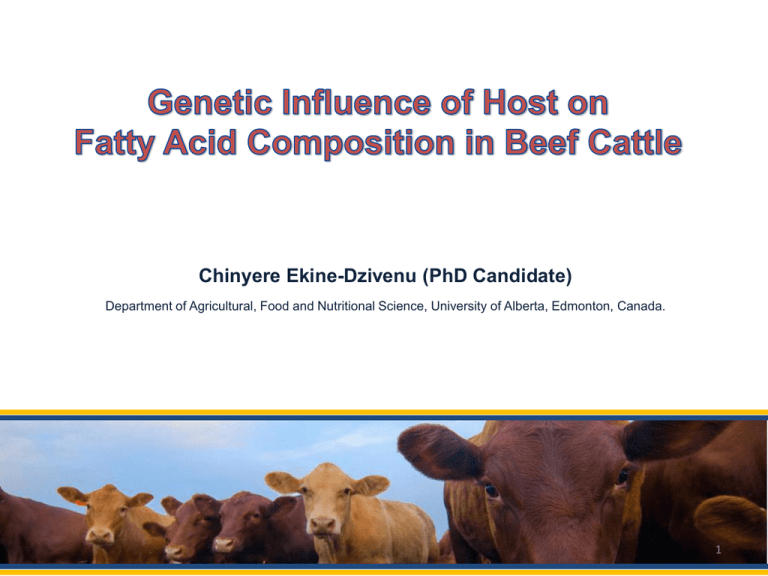Chinyere Ekine-Dzivenu, University of Alberta
advertisement

Chinyere Ekine-Dzivenu (PhD Candidate) Department of Agricultural, Food and Nutritional Science, University of Alberta, Edmonton, Canada. 1 • Background • Objectives • Materials and methods • Results and discussion • Conclusion • Acknowledgement 2 3 • SFA Increased Plasma cholesterol - Cardiovascular diseases - Cancer - Obesity • MUFA & PUFA Reduced plasma cholesterol • CLA Anti-carcinogenic, anti-atherosclerotic Anti-diabetic Anti-Obesity Type of dietary fat (fatty acid profile) matters more than the amount of fat. 4 Improving beef fatty acid composition • Nutrition approach – Added cost – Change not permanent – May affect flavor • Traditional genetic improvement approach – Permanent and accumulative change BUT difficult/expensive to measure and measured after slaughter • Genomics – Marker assisted selection/genomic selection 5 1. Estimate heritability of fatty acids in beef brisket adipose tissue, subcutaneous adipose tissue and longissimus luborum muscle to assess the potential for genetic improvement 2. Estimate phenotypic and genetic correlation between FAs within each tissue in order to prevent antagonism when genetic selection is made 3. Discover SNP markers associated with FA profile in beef for marker assisted selection or marker based diet management 6 7 Phenotype Genotype • Over 80 FA in the brisket adipose on 223 beef steers • Over 80 FA in the subcutaneous adipose and longissimus luborum muscle on 1366 animals • Heritability and correlations estimated using univariate and bivariate animal model implemented in ASreml after accounting for fixed effects. • 961 polymorphic markers for Bayesian candidate gene association study on 8 adjusted data 9 11c_18:1 11t_18:1 13c_18:1 18_2n6 SFA BFA SFA_BFA MUFA PUFA Sum_trans18:1 Sum_CLA Health_Index 11t_18:1 13c_18:1 18:2_n6 SFA BFA SFA_BFA MUFA PUFA Sum_trans18:1 Sum_CLA Health_Index 9c_16:1 9c_16:1 11c_18:1 9c_14:1 9c_14:1 10t_18:1 C18 C18 10t_18:1 C17 C17 9c_18:1 C16 C16 9c_18:1 C15 C15 9c_17:1 Each dot represents an individual animal 9c_17:1 C14 50 0 20 50 PUFA MUFA SFA_BFA BFA SFA 18:2_n6 13c-18:1 11t-18:1 11c-18:1 10t-18:1 9c-18:1 9c-17:1 9c-16:1 9c-14:1 C18 C17 C16 C15 C14 Health_Index Sum_CLA 0 20 50 % FAMEvalue B.Adipose Sum_trans18:1 % FAME S.Adipose value C14 0 20 Muscle % FAME value Fig1. Variation among individual animals for different fatty acids 10 Table 1. Heritability of selected fatty acids in 3 beef tissues Longissimus Luborum Muscle (n=1366) Fatty Acids 14:0 15:0 16:0 17:0 18:0 9c-14:1 9c-16:1 9c-17:1 9c-18:1 10t-18:1 11c-18:1 11t-18:1 13c-18:1 18:2n-6 Sumtrans18:1 SumCLA SFA MUFA PUFA BFA SFA+BFA n-6 n-6/n-3 Health Index Mean 2.8033 0.5024 24.6089 1.5484 12.4073 0.6401 3.4078 1.1913 36.6758 2.0279 1.8358 0.4406 0.3958 4.3871 3.2517 0.395 42.4241 48.5617 6.696 1.3562 43.7803 5.9261 8.6281 1.5654 h2±SE 0.6 ± 0.13 0.22 ± 0.1 0.54 ± 0.1 0.31 ± 0.11 0.33 ± 0.09 0.54 ± 0.09 0.69 ± 0.1 0.17 ± 0.07 0.48 ± 0.09 0.27 ± 0.09 0.24 ± 0.09 0.24 ± 0.08 0.51 ± 0.09 0.28 ± 0.09 0.28 ± 0.09 0.21 ± 0.07 0.48 ± 0.1 0.48 ± 0.09 0.26 ± 0.09 0.17 ± 0.08 0.48 ± 0.09 0.27 ± 0.09 0.44 ± 0.11 0.54 ± 0.1 Subcutaneous Adipose (n=1366) Mean 3.2036 0.6423 25.0924 1.7088 10.5448 1.0459 4.2466 1.3774 37.9173 2.9079 1.9604 0.5455 0.4869 1.8761 4.4859 0.7043 41.5983 52.9408 2.2902 1.7139 43.3122 2.0457 9.2625 1.4875 h2±SE 0.5 ± 0.16 0.25 ± 0.12 0.28 ± 0.09 0.43 ± 0.14 0.43 ± 0.1 0.41 ± 0.1 0.51 ± 0.12 0.18 ± 0.09 0.17 ± 0.07 0.3 ± 0.1 0.03 ± 0.04 0.16 ± 0.07 0.37 ± 0.09 0.43 ± 0.1 0.32 ± 0.09 0.30 ± 0.08 0.39 ± 0.1 0.35 ± 0.09 0.42 ± 0.09 0.24 ± 0.08 0.38 ± 0.1 0.42 ± 0.09 0±0 0.38±0.11 Brisket Adipose (n=223) Mean 3.5452 0.6209 25.5585 1.4033 8.9234 1.4845 5.595 1.4865 40.1263 0.5399 2.4717 0.5399 0.7455 1.2634 2.2963 0.59 40.2913 55.4148 2.8065 1.4874 41.7787 1.4631 7.9869 1.4888 h2±SE 0.17 ± 0.12 0.31 ± 0.12 0.05 ± 0.12 0.17 ± 0.11 0.12 ± 0.11 0.51 ± 0.11 0.13 ± 0.11 0.04 ± 0.1 0.13 ± 0.12 0.11 ± 0.11 0.04 ± 0.11 0.11 ± 0.11 0.43 ± 0.1 0.17 ± 0.13 0.11 ± 0.11 0.06 ± 0.1 High 0.07 ± 0.11 Moderate 0.06 ± 0.1 0.12 ± 0.12 Low 0.03 ± 0.1 Health Index = ΣMUFA +ΣPUFA 4X14:0+16:0 0.06 ± 0.11 ΣMUFA +ΣPUFA 0.16 ± 0.13 HI = 4X14:0+16:0 0.03 ± 0.1 0.16 ± 0.12 11 Brisket adipose Trait SFA MUFA PUFA sumCLA Health Index Subcutaneous adipose Trait SFA MUFA PUFA sumCLA Health Index Longissimus Luborum Table 2. Phenotypic (above diagonal) and genetic (below diagonal) correlation between selected fatty acid groups in beef tissues Trait SFA MUFA PUFA sumCLA Health Index SFA -0.99±0.03 -0.41±0.64 -0.29±0.06 -0.99±0.01 SFA -0.98±0.01 -0.15±0.17 -0.56±0.13 -0.84±0.06 SFA -0.77±0.06 -0.18±0.18 -0.02±0.19 -0.89±0.03 MUFA -0.99±0 0.20±0.82 0.20±0.06 0.96±0.05 MUFA -0.98±0 -0.06±0.17 0.47±0.15 0.87±0.05 MUFA -0.59±0.09 -0.47±0.13 -0.08±0.17 0.75±0.06 PUFA -0.31±0.06 0.17±0.06 0.61±0.04 0.48±0.45 PUFA 0.05±0.09 -0.23±0.09 0.25±0.08 -0.05±0.18 PUFA -0.38±0.11 -0.5±0.06 0.31±0.14 0.09±0.19 SumCLA Health_Index -0.70±0.52 -0.91±0.01 0.70±0.55 0.9±0.01 0.37±0.61 0.23±0.06 0.19±0.06 0.68±0.44 SumCLA -0.08±0.09 -0.03±0.1 0.39±0.14 Health Index -0.85±0.03 0.85±0.03 -0.09±0.11 0.06±0.1 0.36±0.17 SumCLA -0.32±0.09 -0.01±0.08 0.1±0.24 Health Index -0.86±0.02 0.45±0.08 0.43±0.1 0.23±0.11 -0.02±0.19 12 Fig.2. Schematic overview of associations of fatty acids with SNPs in candidate genes. C14 C15 C16 C17 C18 C1419c C1619c C1719c C1819c C18110t C18111c C18111t C18113c C182n6 C171ai sumtrans181 sumCLA SFA MUFA PUFA BFA SFABFA n6 n6n3 Health_index Allele substitution effect indicated by color key TRHR THRSP TFPI2 SLC27A2 SCD RUNX1T1 RARA PNPLA2 NR1H3 LPL IRF2 GAP43 F5 EIF3H CRHR1 CPT2 CAMK2D BRCA1 BDH1 ATP2B1 ATIC AP2B1 ANKRD1 ACADL 13 •NR1H3 •RUNX1T1 •IRF2 •BRCA1 •ANKRD1 Receptors •SLC27A2 •ATP2B1 •AP2B1 Translation Regulator Transporter •SCD •PNPLA2 •LPL •F5 •CPT2 •ACADL •BDH1 •ATIC Transcription Regulator Enzyme Fig 3. Variation in FA among individuals as a result of variation in different cellular processes •CRHR1 •RARA •TRHR •EIF3H 14 15 • Variation exists in the amount of each fatty acid in beef tissues. • Individual animals vary in the amount of each FA deposited in tissues. • Each fatty acid in beef is a complex trait (influenced by several genes). • Identified markers throw light on processes that can cause variation in FA between animals. • Results show possibility of selecting beef with superior genetics to improve not only beneficial FA content but also eating quality of beef. • Results show possibility of simultaneously improving beneficial FA in the adipose. Attention should be paid to the moderate negative correlation between muscle MUFA and PUFA. 16 Phenotypic and genetic correlation of fatty acids in the subcutaneous adipose tissue and longissimus luborum muscle with carcass and meat quality traits Use a higher density SNP panel (bovine 50K SNP chip) to capture more markers explaining a significant amount of variation for beneficial fatty acids among individual animals. 17 • Supervisor: Dr. Changxi Li • Group members, co-investigators and committee Liuhong Chen Michael Vinsky John Basarab Paul Stothard Fiona Buchanan Erasmus Okine • Michael Dugan Jennifer Aalhus Noelia Aldai Tim McAllister Carolyn Fitzsimmons Zhiquan Wang Funding: 18 19






